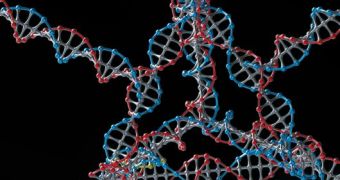Investigators at the Cambridge-based Massachusetts Institute of Technology (MIT) announce that they are now able to produce ribonucleic acid snippets capable of interfering with gene expression in cancer.
The structures they create are made out of RNA and DNA, and are assembled via a construction technique called nucleic acid origami. They are perfectly capable of entering cancer cells, and then shutting down genes whose activity degenerates when the disease starts developing.
This approach enables investigators to attack cancer cells directly and effectively. The type of attack the team set up is based on a natural phenomenon called RNA interference (RNAi), expect it is conducted for different purposes.
Previous attempts at delivering RNA containing the shutdown codes into the target genes have relied on nanoparticles made from polymers or lipids. However, transporting the acid via these structures has proven ineffective.
Scientists from MIT, Alnylam Pharmaceuticals and the Harvard Medical School say that transporting the nucleic acid inside cells is now possible using a mixture of DNA and RNA as a vehicle. There are several advantages to this approach, including 100 percent biocompatibility.
At the same time, the delivery system is biodegradable, meaning that it will eventually be broken down and absorbed into the body, without causing any ill side-effects. For comparison, polymer and lipid nanoparticles had the potential to elicit an inflammatory response in the body.
The new, DNA/RNA transport system can be “outfitted” with vitamin B9, a chemical for which many types of cancer cells appear to have a sweet tooth. Ovarian cancer cells – some of the most difficult to treat of all tumor cells – exhibit this same weakness.
Details of the new study were published in the June 3 issue of Nature Nanotechnology. MIT associate professor of health sciences and technology and chemical engineering, Daniel Anderson, was the senior author. He is also a member of the David H. Koch Institute for Integrative Cancer Research.
“If you take a short interfering RNA and inject it into the bloodstream, it is typically gone in six minutes. If you make a bigger nanoparticle using origami methods, it increases its ability to avoid excretion through the kidneys, thereby increasing its time circulating in the blood,” Anderson says.
Researchers will not stop at treating cancer. They will start to analyze genes that are involved in hereditary conditions as well, in hopes of developing new treatments against these diseases.
As far as cancer therapies go, investigators plan to focus their efforts on identifying and targeting genes responsible for promoting tumor growth.

 14 DAY TRIAL //
14 DAY TRIAL //